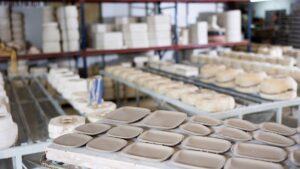High-purity alumina, kaolin and silica: Which ASX explorers are out to bag this polyamorous sand trio?

Industrial minerals are finding new uses and the market is sleeping on a bunch of ASX explorers making waves in the sector. Pic via Getty Images.
The ménage à trois of kaolin, silica and high-purity alumina (HPA) are essential to almost all industrial processes due to their versatility and ability to withstand high temperatures.
These alumina-based materials are used in the creation of advanced ceramic materials with exceptional characteristics such as plasticity, strength, heat resistance and insulation for a range of applications.
While polyamorous in nature, all three also have their own unique properties and can be used individually for a variety of applications – with the refined HPA the most valuable of them all.
Let’s break them up, shall we?
Kaolin, also known as “china clay”, is mainly used as a binder in clay mixtures, cement, paper production and a source of alumina for the production of ceramics because of its fine particle size. Yet also so much more.
Its compound as a type of aluminium silicate makes up an integral part of many manufacturing processes across construction, agriculture, pharmaceuticals and cosmetics.
A derivative of kaolin, halloysite, is gaining plenty of attention of late for its demand in plastics, fine china and porcelain. Kaolin deposits also often host rare earth elements (REE) because of the nature of its clay-hosted geology.
Then there’s the US$21.6bn silica dioxide (SiO2) market, one of the most common minerals on Earth and used primarily to make glass and solar panels, yet also has its uses in tech and other types of manufacturing.
A feedstock from kaolin deposits and coming to the party with >99.99% aluminium oxide (Al2O3) content, HPA is prized for its exceptional purity and plays an important role for tech – especially semiconductors and for our rapid expansion of battery products. It’s the most complex and high-value of the trio, as it requires low iron impurities and refining to create.
Demand is on the up and up, with projections of HPA having a compound annual growth rate (CAGR) of more than 20%, there are a few robust ASX players out there with their eye on getting alumina materials to market.
Which brave ASX adventurers are in this sandbox?
In WA, Kula Gold (ASX:KGD) discovered a sizeable 93.3Mt green kaolin and halloysite deposit in 2021 dubbed “Boomerang” at its Marvel Loch Airfield project near Southern Cross.
KGD says there’s a lot of interest around the deposit as it looks at options to monetise the asset in the current hot kaolin market.
CEO Ric Dawson says the green cement industry is where the focus is at the moment to create ‘metakaolin’ – HPA – as a cement substitute to replace portions of the mixture and are more environmentally friendly to produce, as well as uses in a range of tech applications.
“It’s a niche market and anyone involved in the battery and lighting space needs HPA in the manufacturing process,” Dawson says.
“We’ve got a defined resource and are ticking the boxes for our kaolin and HPA and are assessing the interest in what is a great resource at Southern Cross.”
Plugging away in sandy South Australia, Power Minerals (ASX:PNN) and Andromeda Metals (ASX:ADN) both have kaolin projects on their books in the north region of the Eyre Peninsula.
ADN recently sold its Drummond project to further the development of its flagship Great White kaolin project, which has an ore reserve of 15.1Mt that will produce 300,000tpa over a 28-year mine life.
Earlier this month, PNN expanded its kaolin project after ongoing exploration at its Eyre Peninsula project proved to be very successful and validated its specialty clay strategy “to seek to develop high margin, value-added products for potential supply to advanced technology industries”.
“We are eager to follow up the historic kaolin mineralisation reported in the new licence area to assess its REE and halloysite potential,” PNN MD Mena Habib said.
Meanwhile, Corella Resources (ASX:CR9) has made an MRE upgrade to Tampu, bringing total resources up 21% to a huge 24.7Mt kaolin deposit suitable for HPA feedstock.
The project now has an average yield of ~50% for 12.2Mt @ 36.5% Al2O3 of <45μm very high quality HPA feedstock specification while making a significant reduction in iron oxide (Fe203) top cut to just 0.9%.
Corella says its test work shows that the remaining 50% is suitable for the high-purity silica market which is used to make solar PV cells.
Recently executing an offtake deal with Saudi Arabia for stock from its Victory Bore project, Surefire Resources (ASX:SRN) is progressing a pre-feasibility study of its 37.7Mt @ 23.3% Al203 and the mutually exclusive, world-class 321Mt @ 0.04% vanadium deposit.
And Impact Minerals (ASX:IPT) is progressing well at its Lake Hope HPA project which has maiden resource of 3.5Mt @ 25.1% Al2O3 for a contained 880,000t of alumina.
While Impact Minerals, Corella Resources, Kula Gold and Power Minerals are Stockhead advertisers, they did not sponsor this article.
This article does not constitute financial product advice. You should consider obtaining independent advice before making any financial decisions.
UNLOCK INSIGHTS
Discover the untold stories of emerging ASX stocks.
Daily news and expert analysis, it's free to subscribe.
By proceeding, you confirm you understand that we handle personal information in accordance with our Privacy Policy.








